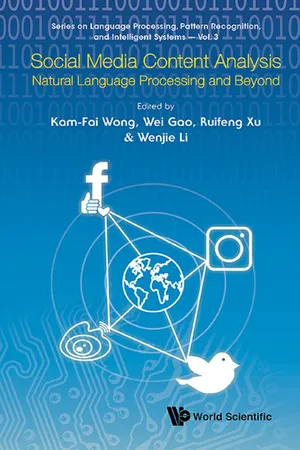
Social Media Content Analysis
Natural Language Processing and Beyond
- 199 pages
- English
- ePUB (mobile friendly)
- Available on iOS & Android
Social Media Content Analysis
Natural Language Processing and Beyond
About This Book
-->
Social media platforms have been ubiquitously used in our daily lives and are steadily transforming the ways people communicate, socialize and conduct business. However, the growing popularity of social media adversely leads to wild spread of unreliable information. This in turn inevitably creates serious pollution problem of the global social media environment, which is harmful against humanity. For example, President Donald Trump used social media strategically to win in the 2016 USA Presidential Election. But it was found that many messages he delivered over social media were unproven, if not untrue. This problem must be prevented at all cost and as soon as possible. Thus, analysis of social media content is a pressing issue. It is a timely and important research subject worldwide. However, the short and informal nature of social media messages renders conventional content analysis, which is based on natural language processing (NLP), ineffective. This volume consists of a collection of highly relevant scientific articles published by the authors in different international conferences and journals, and is divided into three distinct parts: (I) search and filtering; (II) opinion and sentiment analysis; and (III) event detection and summarization. This book presents the latest advances in NLP technologies for social media content analysis, especially content on microblogging platforms such as Twitter and Weibo.
--> Contents:
- Search and Filtering:
- Ranking Model Selection and Fusion for Effective Microblog Search (Z Wei, W Gao, T El-Ganainy, W Magdy and K-F Wong)
- Microblog Search and Filtering with Real-Time Dynamics Based on BM25 (W Gao, Z Wei and K-F Wong)
- Exploring Tweets Normalization and Query Time Sensitivity for Twitter Search (Z Wei, W Gao, L Zhou, B Li and K-F Wong)
- A Hierarchical Knowledge Representation for Expert Finding on Social Media (Y Li, W Li and S Li)
- Twitter Hyperlink Recommendation with User-Tweet-Hyperlink Three-Way Clustering (D Gao, R Zhang, W Li and Y Hou)
- Detect Rumors Using Time Series of Social Context Information on Microblogging (J Ma, W Gao, Z Wei, Y Liu and K-F Wong)
- An Empirical Study on Uncertainty Identification in Social Media Context (Z Wei, J Chen, W Gao, B Li, L Zhou, Y He and K-F Wong)
- Detecting Semantic Uncertainty by Learning Hedge Cues in Sentences Using an HMM (X Li, W Gao and J W Shavlik)
- Opinion and Sentiment Analysis:
- A Unified Graph Model for Sentence-Based Opinion Retrieval (B Li, L Zhou, S Feng and K-F Wong)
- Intersubjectivity and Sentiment: From Language to Knowledge (L Gui, R Xu, Y He, Q Lu and Z Wei)
- Event-Driven Emotion Cause Extraction with Corpus Construction (L Gui, R Xu, D Wu, Q Lu and Y Zhou)
- Learning Task Specific Distributed Paragraph Representations Using a 2-Tier Convolutional Neural Network (T Chen, R Xu, Y He and X Wang)
- Build Emotion Lexicon from Microblogs by Combining Effects of Seed Words and Emoticons in a Heterogeneous Graph (K Song, S Feng, W Gao, D Wang, L Chen and C Zhang)
- Personalized Sentiment Classification Based on Latent Individuality of Microblog Users (K Song, S Feng, W Gao, D Wang, G Yu and K-F Wong)
- Efficient Feedback-Based Feature Learning for Blog Distillation as a Terabyte Challenge (D Gao and W Li and R Zhang)
- Inferring Topic-Dependent Influence Roles of Twitter Users (C Chen, D Gao, W Li and Y Ho)
- A Constrained Multi-View Clustering Approach to Influence Role Detection (C Chen, D Gao, W Li and Y Ho)
- Event Detection and Summarization:
- Using Content-Level Structures for Summarizing Microblog Repost Trees (J Li, W Gao, Z Wei, B Peng and K-F Wong)
- Utilizing Microblogs for Automatic News Highlights Extraction (Z Wei and W Gao)
- Gibberish, Assistant, or Master? Using Tweets Linking to News for Extractive Single-Document Summarization (Z Wei and W Gao)
- Using Tweets to Help Sentence Compression for News Highlights Generation (Z Wei, Y Liu, C Li and W Gao)
- Joint Topic Modeling for Event Summarization Across News and Social Media Streams (W Gao, P Li and K Darwish)
- Automatic Twitter Topic Summarization with Speech Acts (R Zhang, W Li, D Gao and Y Ouyang)
- Sequential Summarization: A Full View of Twitter Trending Topics (D Gao, W Li, X Cai, R Zhang and Y Ouyang)
- TGSum: Build Tweet Guided Multi-Document Summarization Dataset (C Chen, W Li, S Li, F Wei and M Zhou)
- Topic Extraction from Microblog Posts Using Conversation Structures (J Li, M Liao, W Gao, Y He and K-F Wong)
- Exploiting Community Emotion for Microblog Event Detection (G Ou, W Chen, T Wang, Z Wei, B Li, D Yang and K-F Wong)
- Tracking Sentiment and Topic Dynamics from Social Media (Y He, C Lin, W Gao and K-F Wong)
-->
--> Readership: Academics and researchers in social media content analysis and natural language processing. -->
Keywords:Social Media;Natural Language Processing;Information Retrieval;Content AnalysisReview:0
Frequently asked questions
Information
Chapter 1
Ranking Model Selection and Fusion for Effective Microblog Search
The Chinese University of Hong Kong, Shatin, N.T., Hong Kong SAR
{zywei, kfwong}@se.cuhk.edu.hk
P.O. Box 5825, Doha, Qatar
{wgao, telganainy, wmagdy}@qf.org.qa
1.Introduction
2.Related Work
3.Ranker Selection and Fusion
Table of contents
- Cover
- Halftitle
- Title
- Copyright
- Preface
- Contents
- About the Editors
- Part I: Search and Filtering
- Part II: Opinion and Sentiment Analysis
- Part III: Event Detection and Summarization